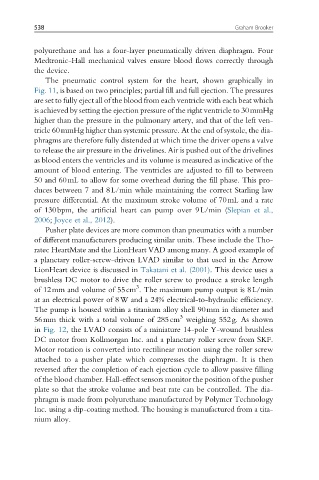Page 544 - Handbook of Biomechatronics
P. 544
538 Graham Brooker
polyurethane and has a four-layer pneumatically driven diaphragm. Four
Medtronic-Hall mechanical valves ensure blood flows correctly through
the device.
The pneumatic control system for the heart, shown graphically in
Fig. 11, is based on two principles; partial fill and full ejection. The pressures
are set to fully eject all of the blood from each ventricle with each beat which
is achieved by setting the ejection pressure of the right ventricle to 30mmHg
higher than the pressure in the pulmonary artery, and that of the left ven-
tricle 60mmHg higher than systemic pressure. At the end of systole, the dia-
phragms are therefore fully distended at which time the driver opens a valve
to release the air pressure in the drivelines. Air is pushed out of the drivelines
as blood enters the ventricles and its volume is measured as indicative of the
amount of blood entering. The ventricles are adjusted to fill to between
50 and 60mL to allow for some overhead during the fill phase. This pro-
duces between 7 and 8L/min while maintaining the correct Starling law
pressure differential. At the maximum stroke volume of 70mL and a rate
of 130bpm, the artificial heart can pump over 9L/min (Slepian et al.,
2006; Joyce et al., 2012).
Pusher plate devices are more common than pneumatics with a number
of different manufacturers producing similar units. These include the Tho-
ratec HeartMate and the LionHeart VAD among many. A good example of
a planetary roller-screw-driven LVAD similar to that used in the Arrow
LionHeart device is discussed in Takatani et al. (2001). This device uses a
brushless DC motor to drive the roller screw to produce a stroke length
3
of 12mm and volume of 55cm . The maximum pump output is 8L/min
at an electrical power of 8W and a 24% electrical-to-hydraulic efficiency.
The pump is housed within a titanium alloy shell 90mm in diameter and
3
56mm thick with a total volume of 285cm weighing 552g. As shown
in Fig. 12, the LVAD consists of a miniature 14-pole Y-wound brushless
DC motor from Kollmorgan Inc. and a planetary roller screw from SKF.
Motor rotation is converted into rectilinear motion using the roller screw
attached to a pusher plate which compresses the diaphragm. It is then
reversed after the completion of each ejection cycle to allow passive filling
of the blood chamber. Hall-effect sensors monitor the position of the pusher
plate so that the stroke volume and beat rate can be controlled. The dia-
phragm is made from polyurethane manufactured by Polymer Technology
Inc. using a dip-coating method. The housing is manufactured from a tita-
nium alloy.

